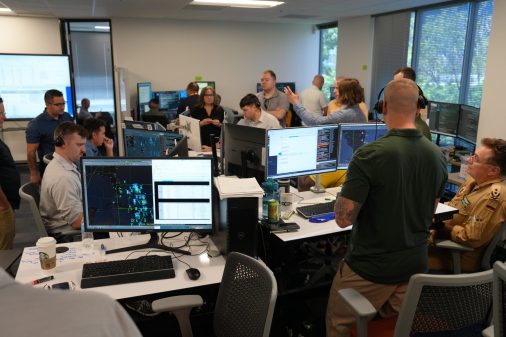Winston Beauchamp retires from federal service after 29 years at Air Force, IC

After nearly three decades of working for the U.S. government, Winston Beauchamp announced on July 4 that he’s departing from his role within the Department of the Air Force and leaving active federal service.
Beauchamp began working for the department in 2015, and most recently served as the director of security, special program oversight and information protection within the Office of the Secretary of the Air Force. In that role, he oversaw the Air and Space Forces’ highly-classified special access programs (SAP) and worked on insider threat mitigation.
But Beauchamp’s 29-year career spans across multiple positions at the Department of the Air Force, the National Geospatial-Intelligence Agency (NGA) and the Office of the Director of National Intelligence (ODNI). By and large, he either led or was involved in several critical events within the national security space — so much so that someone once described him as “the Forrest Gump of the national security world.”
“He goes, ‘You were kind of there in all the big happenings of your time of your career. You were right in the middle of all these things that were the big developments. Sometimes you were there in the background of the scene, and sometimes you were there front and center doing the thing,’” Beauchamp told DefenseScoop in an interview on July 3, his last day at the Pentagon, recalling how a colleague described his tenure.
After graduating from Lehigh University in 1992, Beauchamp was hired as a systems engineer for General Electric Aerospace’s programs with the National Reconnaissance Office (NRO). He would eventually move to the National Imagery and Mapping Agency (NIMA) — the precursor to the NGA — after it was founded in 1996 as an operations analyst supporting work to collect imagery and targeting data in the Balkans during the Yugoslav Wars.
In 2000, Beauchamp became NIMA’s senior technical advisor for studies and analysis when he was 29 years old, making him the youngest person to be hired for a senior executive position within the agency since it was founded. Almost immediately, he was tasked with developing a congressionally mandated strategy that would convince the government to purchase imagery from commercial vendors.
At the time, the IC held a monopoly over space-based imagery and data, and the industry market was only just beginning to take hold. Beauchamp described the assignment as “trying to sell milk to people with their own cows.”
“Why would the NRO want to encourage the government to buy commercial imagery? They’re the judge to build and operate imagery satellites,” he said. “So I figured out what it would take in terms of investment to get industry to buy and build satellites sufficient to meet the government’s demands, because the national satellites were not meeting all of the government’s demand for mapping data.”
But after developing a business case for the strategy, Beauchamp said the government was largely opposed to implementing it. He decided to shelve the strategy after one final unsuccessful meeting held on Sept. 10th, 2001, he said.
“On the 11th of September, [Congress] called me up,” he said. “I’m in my office, we’re watching pictures of the [Twin Towers] smoking, and my phone rings and it’s the congressional staff saying, ‘You’ve got your money. Could you spend more?’”
Beauchamp’s $830 million plan was funded by one of Congress’ post-9/11 supplemental packages and created ClearView — the first program that allowed commercial companies to provide satellite imagery to the IC. Once U.S. forces had entered Afghanistan, Beauchamp also moved to purchase all of the overhead imagery of the country, he said.
“What we really wanted to do was make sure that this imagery that was being collected wasn’t being used by the Taliban to target our forces,” he said. “So I basically stitched a camouflage net made out of $100 bills over the country of Afghanistan in order to keep our forces safe.”
Today, commercially derived imagery is one of the fastest growing markets in the world. Companies like Maxar, BlackSky and Planet Labs all have several lucrative contracts with the federal government to provide space-based data for national security, weather and other needs.
“So this industry, would it exist? Maybe. But would it have blown up the way it did? Probably not, if we hadn’t done this,” Beauchamp said.
The next several years of Beauchamp’s career would be spent at the NGA in various roles focused on strategy and acquisition. In 2012, he began a joint duty assignment as the ODNI’s director of mission integration under then-Director of National Intelligence Gen. James Clapper — a job he noted was one of the highlights of his career. During his second day on the job, U.S. government facilities in Benghazi, Libya, were targeted by militant groups, leading to the death of four American citizens.
Once Beauchamp’s team finished the assessment of the attack, he was immediately thrust into the fallout of the classified document leaks by Edward Snowden in 2013. His oversight led to a massive reform of the IC’s compartmented access programs and yet another overhaul of the government’s policy on commercial imagery.
“All of a sudden, now I’m convening people on the analytics side [and the] collection side, trying to figure out how to make up for the losses and capability that Snowden revealed,” he said. “And part of that is doing a reform of the IC’s compartmented programs, because they had way too many of them in overlap.”
Toward the end of his three-year assignment, Beauchamp started working with former Deputy Secretary of Defense Bob Work on a “side project” focused on standing up a new organization to pivot the Defense Department away from counterterrorism operations in the Middle East and towards great power competition, he said.
Beauchamp’s time in the intelligence community came to an end in 2015, when he was picked to be the Department of the Air Force’s deputy undersecretary for space and director of the principal DOD space advisor. There, he had two critical tasks, he noted.
“One, I’m working with all the international relationships with other countries who want to cooperate with us in space,” Beauchamp said. “At the same, I’m trying to convince the Americans to shift from space as a sanctuary from which you provide services, to space as a domain for warfighting.”
At the time, the Pentagon was reluctant to expand operations in space out of fear of being the first to weaponize the domain. But Beauchamp argued that the idea wasn’t about weaponization, and instead protection of critical space-based capabilities.
“It’s almost like before then, we were deliberately not protecting them so as you didn’t look like you wanted to start something,” he said. “And I was like, ‘This is not an option anymore.’ The Chinese had already demonstrated they could shoot down their own satellites, what’s to stop them from doing the same thing to us?”
Part of Beauchamp’s work was to develop a plan for how the Pentagon could make its space systems more resilient — many of which have become central to the Space Force’s operations, he noted. And when the first Trump administration decided to stand up the Space Force, Beauchamp was at the forefront of the effort to convince officials to approve the new military service.
Beauchamp would then transition to the Department of the Air Force’s office of the CIO, first as its director of enterprise IT in 2018 and later as the deputy CIO in 2020. His main focus was preparing the DAF for transitioning to telework operations as the COVID-19 pandemic spread across the globe, as well as consolidating the department’s enterprise licenses and creating a plan for modernizing base-level infrastructure, he noted.
“The overall trend line was eliminating the county option of uniqueness that was taking place at every base, and replacing it with a core set of enterprise services that were provided centrally,” Beauchamp said. “Big things like moving to zero trust — you can’t do those things if every base and every two-letter has their own architecture independent of everybody else’s.”
Today, the DAF has a strong path forward on modernizing its IT infrastructure, but Beauchamp said the true challenge will be convincing the department’s major programs to rely on enterprise services instead of building their own networks.
“It’s going to allow them to consolidate and collapse multiple redundant networks and really reduce the amount of money we’re spending on sustaining all this infrastructure,” he said. “When you modernize those networks, you also improve your cybersecurity, because the more deviation you have, the more gaps are created between the different baselines and different versions of software.”
Moving forward, Beauchamp said he will be taking time off but is open to other opportunities in the future.
“I’m excited for whatever the next challenge might be,” he said. “I’m interested in talking to folks who do exciting things, and to see who needs somebody like me to solve big problems.”






